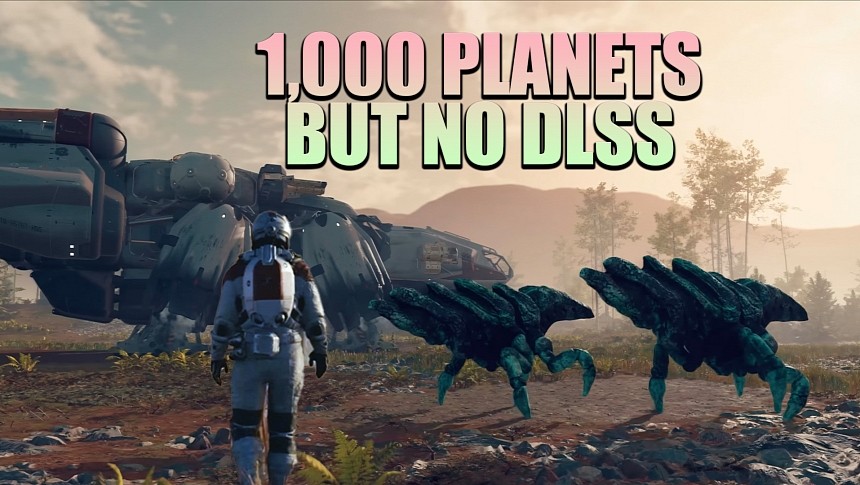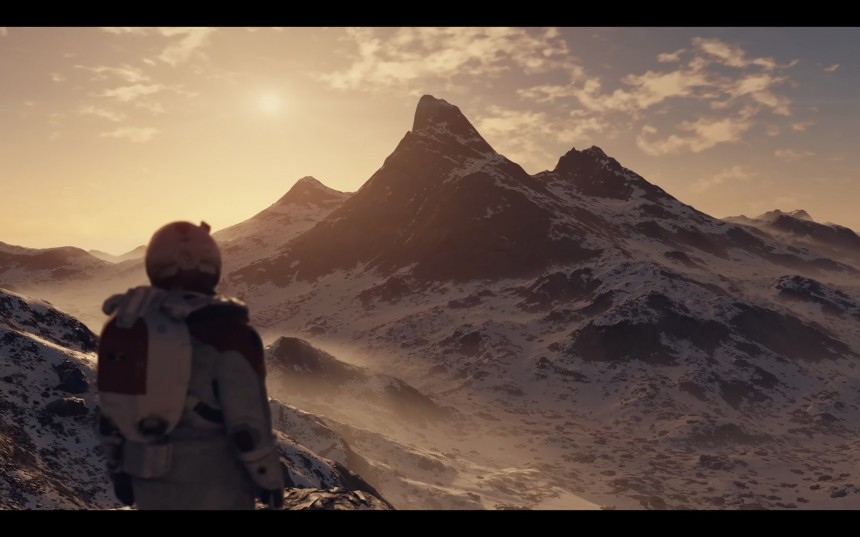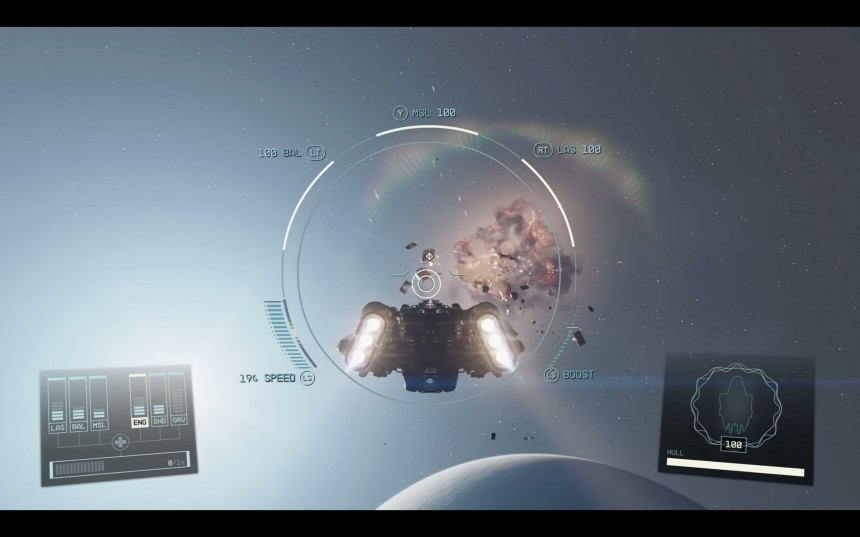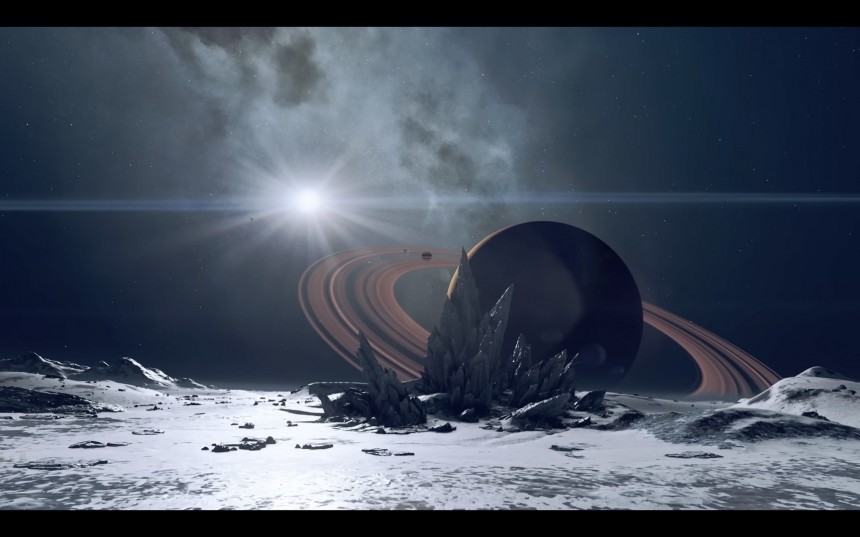It's no secret that Bethesda's Starfield has been in the spotlight lately, and not in the flattering sort of light. After several delays and the entire 30 vs. 60 fps sandwich debacle, things were finally starting to cool off for Starfield, when it took another hit to the main hull. Bethesda recently announced that the game would launch on PC with AMD FSR, and there was no mention of other upscaling technologies from the competition.
One of the Starfield trailers starts with a soothing British female voice saying: "We're all here because we're all committed to the biggest question of all. What's out there?" Well, part of the answer to that question is, "Not DLSS, or Intel XeSS, it seems."
In that trailer, there was a lot of PR talk regarding how AMD software technologies can take Starfield to the next graphical level and all that jazz, but technically, that's not entirely accurate.
Before entering full-on game development, devs have to "pick a side," so to speak, concerning which GPU camp they will adopt. For console games, AMD is the one-and-only choice because platforms like the PS5 and Xbox only use AMD-based CPUs and GPUs, so they're stuck with that for the duration of the generation.
However, when it comes to porting their games for PC, that's an entirely different story because devs can optimize their game for AMD, Nvidia, and Intel cards, with no compromises for the player. They don't have to "pick" a side, short of development constraints like time, budget, or both, which could be the case here.
This story concerns one specific piece of software responsible for upscaling your game's image from a lower resolution to a higher one to maintain higher framerates than your hardware would typically be capable of outputting by using the classical rasterization process, which is just raw power.
It's called AMD FSR 2, stands for FidelityFX Super Resolution, and can run on Nvidia graphics cards, but it's not as cracked up as Besthesda makes it out to be. First, it's old tech by now, even though AMD updates it occasionally.
Second, Nvidia's DLSS is far superior, and I tested this out with my own eyes in games like Resident Evil 4 at Ultra Settings in 4K. FSR 2 on Quality made the game look blurry, while Nvidia DLSS 2 on Quality was lightyears ahead (pun intended) in terms of visual clarity and performance.
FSR gave me a 15-20 fps bump, whereas, with DLSS, I got 20-30 more frames per second. It's no industry secret that DLSS is simply better. Not to mention DLSS 3, which in games that support it, adds another 15-20 frames on top of DLSS 2.
Another proven case is Star Wars: Jedi Survivor, which was also advertised with FSR optimization and whatnot and launched with no DLSS option. The game was a mess at first, and only thanks to modders like "PureDark" did we get some technical relief when they implemented an "aftermarket" DLSS 3 mod that made it run much better.
Now, like the hero we need but don't deserve, PureDark has claimed once more that they will save us from the blurry visual grasp of Starfield's FSR tech and deliver us a mod with DLSS support.
Exclusivity deals between developers, publishers, and hardware manufacturers happen all the time in the industry. The current FTC vs. Sony vs. Microsoft debacle has at least shown us that with no room for interpretation.
In all fairness, this doesn't mean Bethesda or Microsoft are ill-willed toward players. Their ultimate goal is to attend to everyone's needs and make people happy no matter which gaming platform they play Starfield on. Well, as long as it's not PS5, because... you know, it's not coming out on PlayStation.
So offering them the benefit of the doubt and considering the 1+ year in delays Starfield has gone through, this entire thing might be a simple case of time constraints more than anything else. No one at Bethesda is staging a coup against Nvidia players.
Todd Howard, Game Director, hasn't explicitly mentioned that support for DLSS or Intel's upscaling technology, XeSS, isn't coming further down the line. Would it have been better for everyone involved to have all three technologies present at launch? Of course!
But a game like Starfield most likely costs north of $300 million to develop. For a studio as large as Bethesda Game Studios, with more than 400 employees reported in 2021, 2-3-4 more months in development just to implement them would mean spending tens of millions more.
Starfields hits Xbox and PC on September 6, but it will also be available through the Game Pass subscription service, so I'd strongly advise you to try it there for $15 a month before going on a spending spree and forking out $70.
Worst case scenario, if you don't like it, you have 100 more games where that came from.
In that trailer, there was a lot of PR talk regarding how AMD software technologies can take Starfield to the next graphical level and all that jazz, but technically, that's not entirely accurate.
Before entering full-on game development, devs have to "pick a side," so to speak, concerning which GPU camp they will adopt. For console games, AMD is the one-and-only choice because platforms like the PS5 and Xbox only use AMD-based CPUs and GPUs, so they're stuck with that for the duration of the generation.
However, when it comes to porting their games for PC, that's an entirely different story because devs can optimize their game for AMD, Nvidia, and Intel cards, with no compromises for the player. They don't have to "pick" a side, short of development constraints like time, budget, or both, which could be the case here.
It's called AMD FSR 2, stands for FidelityFX Super Resolution, and can run on Nvidia graphics cards, but it's not as cracked up as Besthesda makes it out to be. First, it's old tech by now, even though AMD updates it occasionally.
Second, Nvidia's DLSS is far superior, and I tested this out with my own eyes in games like Resident Evil 4 at Ultra Settings in 4K. FSR 2 on Quality made the game look blurry, while Nvidia DLSS 2 on Quality was lightyears ahead (pun intended) in terms of visual clarity and performance.
FSR gave me a 15-20 fps bump, whereas, with DLSS, I got 20-30 more frames per second. It's no industry secret that DLSS is simply better. Not to mention DLSS 3, which in games that support it, adds another 15-20 frames on top of DLSS 2.
Now, like the hero we need but don't deserve, PureDark has claimed once more that they will save us from the blurry visual grasp of Starfield's FSR tech and deliver us a mod with DLSS support.
Exclusivity deals between developers, publishers, and hardware manufacturers happen all the time in the industry. The current FTC vs. Sony vs. Microsoft debacle has at least shown us that with no room for interpretation.
In all fairness, this doesn't mean Bethesda or Microsoft are ill-willed toward players. Their ultimate goal is to attend to everyone's needs and make people happy no matter which gaming platform they play Starfield on. Well, as long as it's not PS5, because... you know, it's not coming out on PlayStation.
Todd Howard, Game Director, hasn't explicitly mentioned that support for DLSS or Intel's upscaling technology, XeSS, isn't coming further down the line. Would it have been better for everyone involved to have all three technologies present at launch? Of course!
But a game like Starfield most likely costs north of $300 million to develop. For a studio as large as Bethesda Game Studios, with more than 400 employees reported in 2021, 2-3-4 more months in development just to implement them would mean spending tens of millions more.
Starfields hits Xbox and PC on September 6, but it will also be available through the Game Pass subscription service, so I'd strongly advise you to try it there for $15 a month before going on a spending spree and forking out $70.
Worst case scenario, if you don't like it, you have 100 more games where that came from.

































